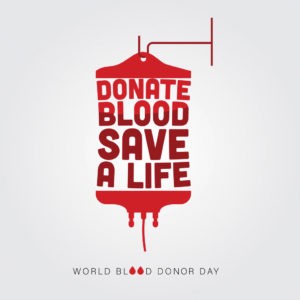Help Save Lives

Story by Ann E. Butenas
The month of January is a time to recognize the importance of donating blood and platelets for the lifesaving impact that precious gift to others will have.
It’s amazing just how much a single drop of blood can make a significant difference. When you give the gift of blood, you are essentially giving a gift to someone’s life. January is typically the time of year when blood shortages occur, as people tend to stop donating over the holidays and when they become ill with the cold or flu. Further, bad winter weather can cause blood drives to shut down.
On December 31, 1969, then-President Richard M. Nixon signed a proclamation that designated the month of January of each year as National Blood Donor Month (NBDM). This month is meant to honor those who donate their blood and to encourage and inspire others to do the same, especially at a time when more blood donations are needed across the country.
Donating blood is one of the most altruistic things you can do for others in need. In just about an hour of your time, you can donate a unit of blood that can then be divided into four separate components that have the potential to save many lives.

From that one unit of blood, red blood cells can be taken out and used in treatments for patients who have lost blood due to trauma or who are recovering from surgical procedures. Further, the liquid part of the blood, referred to as plasma, is usually given to patients who need treatment to improve blood clotting. Finally, the platelets assist in helping the blood clot when someone has sustained a cut or other type of open wound. Platelets are also administered to patients with cancer or who have undergone an organ transplant.
 As for the general requirements for blood donors, you must be at least 16 years of age and weigh at least 100 pounds and be in general good health. You will undergo a pre-donation screening which consists of questions from a blood bank employee about your overall health, lifestyle, and any potential disease risk factors that could prevent you from donating. You will then be given a short health exam that includes taking your pulse, temperature, and blood pressure. While the actual donation process takes about 10 minutes, plan to be available for up to an hour. The entire process includes registration and post-donation refreshments.
As for the general requirements for blood donors, you must be at least 16 years of age and weigh at least 100 pounds and be in general good health. You will undergo a pre-donation screening which consists of questions from a blood bank employee about your overall health, lifestyle, and any potential disease risk factors that could prevent you from donating. You will then be given a short health exam that includes taking your pulse, temperature, and blood pressure. While the actual donation process takes about 10 minutes, plan to be available for up to an hour. The entire process includes registration and post-donation refreshments.
If it is determined you are not a suitable blood donor, you can still participate by referring someone who might be. Alternatively, blood banks are always looking for volunteers to help with blood draws or to organize any mobile blood drives. Additionally, monetary donations are greatly appreciated to help the blood banks continue to operate.
You can donate blood at many locations, too, from bloodmobiles to blood drives that are held at places of work, schools, and churches. You may also donate at community blood centers and hospital-based blood donor centers. When you donate blood, about 0.5 L of blood will be collected. If you wish to donate other blood products such as plasma or platelets, the amount that is collected from you varies in accordance with your weight, height, and platelet count.
Giving blood is a great way to give to your local community and hospitals. It is definitely a “feel good” thing to do. Plus, you never know when you or someone you love may be on the receiving end of such a special gift. So, if you have ever wanted to become a superhero, this is your opportunity. To learn more about National Blood Donor Month, go online at AmericasBlood.org. You can also learn more about donating at RedCrossBlood.org or call 1.800.RED CROSS (1-800-733-2767).


